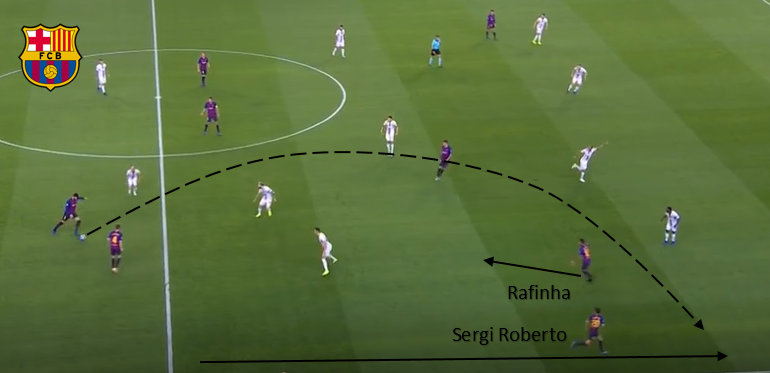WORLD CLASS COACHING
Spanish Style Possession Soccer Vol 1
By Philip Cauchi
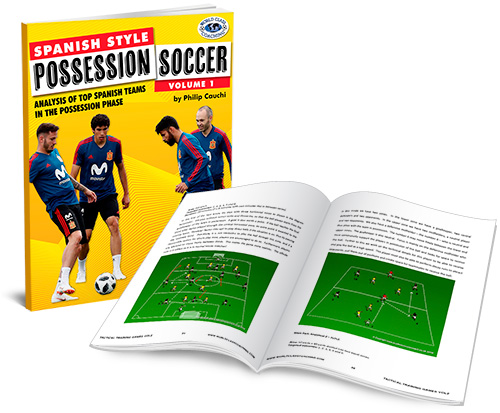
Table of Contents
PART TWO
Positional Characteristics During the Possession Phase
Positional characteristics during the possession phase
The goalkeeper
In addition to shot stopping and command of the penalty area, Spanish goalkeepers are typically good at playing with their feet. They participate actively in the build-up and are able to play both short and long passes. The positional awareness and composure of Spanish goalkeepers is outstanding and this enables them to play intelligently and quickly even when under pressure.
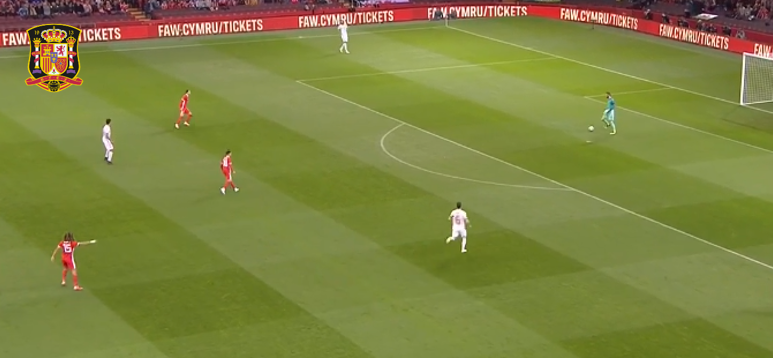
When the goalkeeper is in possession of the ball, options to play from the back are usually created by both the central defenders and central midfielders (usually the deepest one). The movements created by these players enable the goalkeeper to have multiple options to play the ball. However, the primary principle of play in Spain is to play the pass that takes as many opponents as possible out of the game while ensuring that the team retains possession of the ball. In the next diagram we can note that if the ball was played to any of the two central defenders, the attackers could easily track back and remain behind the line of the ball. Furthermore, the team would not have gained any territorial advantage. As is the case in this situation, the goalkeeper played the ball to the central midfielder, eliminating two opponents in the process while putting the team in an advantageous position to continue with a forward attack momentum. If the option to play to the central midfielder was not available, either as result of having this player marked and/or having the strikers positioned in a way which prevented the ball from reaching him, the ball would have been played through the central defenders.
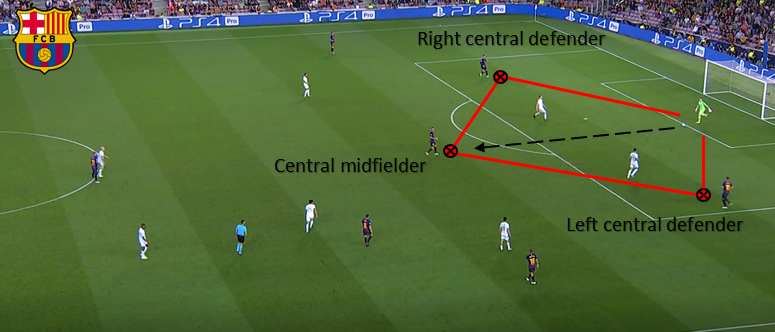
The central defenders
While being strong in the defensive phase, the central defenders are highly skilled and able to play with composure to get the ball out of pressure and build a constructive attack. They are ball playing defenders who play very close with the goalkeeper, midfielders and full backs. Their main aim in the possession phase is to start or re-cycle the build-up upon recovering the ball. In some teams like F.C. Barcelona and Real Madrid C.F. they play high inside the opponents’ half where they are always available as a backwards safe option to switch the point of attack.
During the build-up, the central defenders drop deep to create space for themselves to receive the ball. This opens up the necessary passing lanes to play the ball back whenever the midfielders or full backs cannot play forward. By dropping deep into space, the central defenders are giving the team more options during the build-up phase and also more security at the back. Players like Sergio Ramos of Real Madrid and Piqué of Barcelona communicate well with their teammates. This enables the team to achieve a forward momentum to develop quick and accurate attacks. The positon of the central defensive midfielder helps the back line by providing more passing options for the build-up. In the next image, Busquets of Barcelona remains central and is being shadow marked by two Rayo Vallecano forwards. Although the pass to him is not on, his position has attracted two Rayo forwards which in turn has provided the central defender on the ball with space to dribble forward and play towards the left flank.
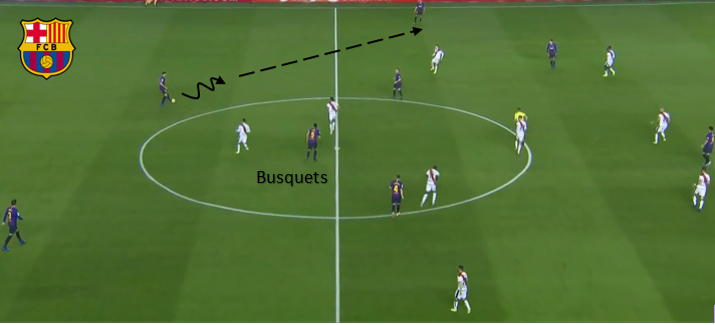
Central defenders of Spanish top teams as well as the national side have outstanding positional awareness. This gives their teams the required momentum to push forward and keep circulating the ball well inside the opposition’s half. Short and sharp passes as well as positional rotations (mobility) are key to pulling the opponents out of well covered zones in order to play deep.

Look at the below photo and note how the national team of Spain are able to build-up play from the two central defenders while the opponents retain a medium block. In this case the two central defenders play at close proximity to each other while two central midfielders move into the correct space to show for passes.
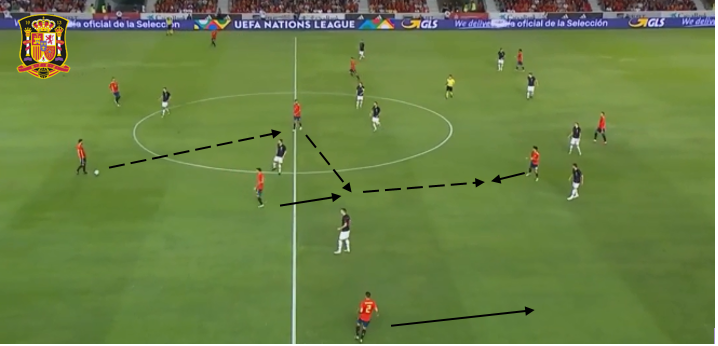
During the first stage of the build-up, teams may either choose to have the central defenders play close to each other or to stretch to the edge of the penalty area. In the latter the low playmaker should then drop to play close to the central defenders. This provides more options to play the ball out from the back and retains balance to the structure of the team.
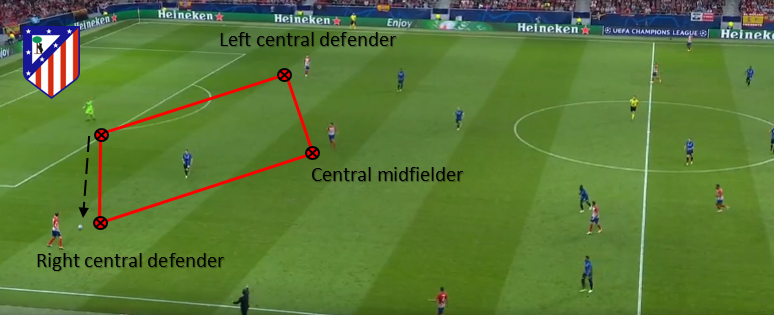
When in possession of the ball the central defenders drop deep so to be able to receive back passes without pressure. Top teams typically play the ball back to their central defenders to switch the point of attack. The central defenders are also in a good positions to close down space and the team becomes compact should the ball be lost further up the field. In the next image one of the central defenders (Piqué) drops deep while the other (Lenglet) moves up in space ready to receive in a more advanced position and without being contrasted by the opponents. Both Piqué and Lenglet are free. However, being in a central position, Lenglet has more options to play. When the ball is played to him, the team opens up, creating width, depth and length.
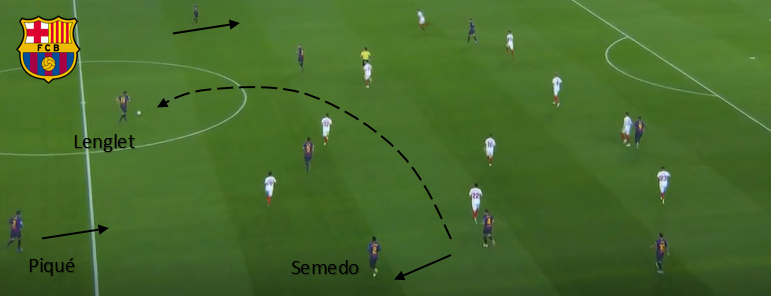
In the middle of the field, the central defensive midfielder’s position determines the distance between the two central defenders. If the defensive midfielder moves up in midfield, the central defenders remain close to each other both to support the midfielder in front of them, and each other should one of them receives the ball. On the other hand if the defensive midfielder remains deep, the two central defenders get wider so that they can circulate the ball and switch play with ease and speed. The team will also have three players are the back who are compact and ready to defend if the ball is lost in higher areas of the pitch.
The central midfielders
The central midfielders are crucial to possession play. They are the engine of such a style as the build-up occurs through them, and as Allison (2013) describes them they are the beating heart of the team. They are constantly under pressure to create space to receive and feed the forwards or other players coming from deeper positions such as full backs attacking down the flanks. Central midfielders work very close with the defenders during the build-up phase. They typically insert themselves between the two central defenders to create better angles when building up from the back. In Spain the typical defensive midfielder is also highly technical. Usually he is the one initiating play as his ability to read the game is high.
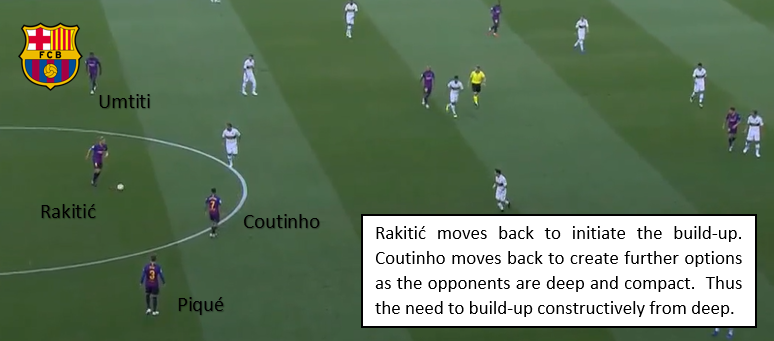
Both on and off the ball, central midfielders are very quick. This is due to the high level of tactical intelligence that they possess. They rapidly lose their marker to gain space, are able to identify the right moment to create space for teammates, and are also very quick during counter attacking situations.
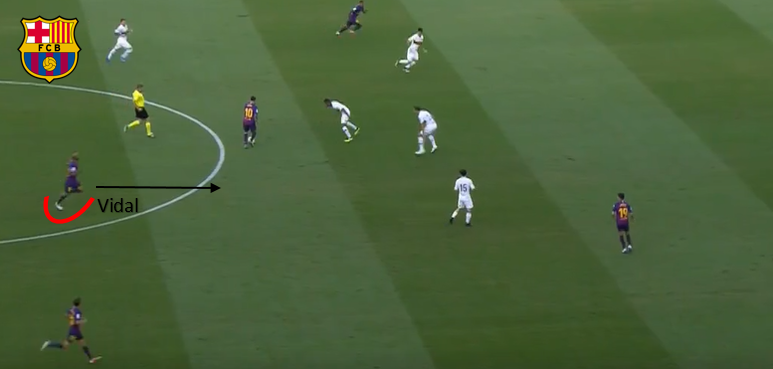
Overloading the attack is another important feature of central midfielders. When a goal-scoring opportunity is being created, Spanish teams attack with numbers, creating more options inside and around the penalty area.
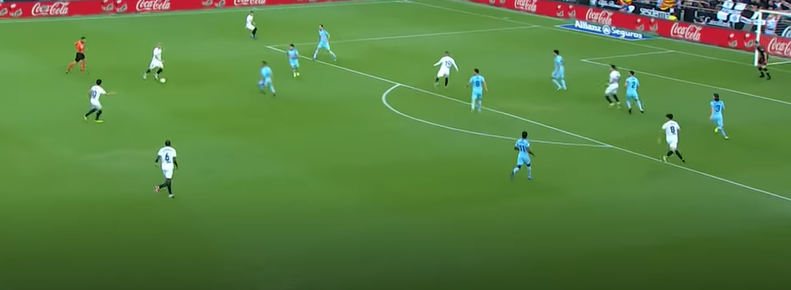
By being positioned outside the penalty area, midfielders offer the team an option to quickly change the angle of an attack. Furthermore, if the ball is played into the penalty area and possession is lost, they are in the correct positions to quickly apply pressure, thus preventing the opponents from countering (counter press). The whole team thus moves together to remain compact with various players being at a close proximity to each other. Geometry of the angles and shapes created on the field of play is something which Spanish teams excel at. The midfielders are continuously aided by both full backs and forwards to create numerical overloads, thus increasjng the options of playing the ball to either attack depth or retain possession (Allison, 2013).
Central midfielders are constantly moving and changing positions. This makes it very hard to mark them as they aim to continuously pull the opposing team’s midfielders out of central coverage. A great midfielder does not necessarily create space for himself to receive. His movement might be needed to play the ball into more advanced areas on the field of play. In the next diagram Kroos moves back to create space for Bale to receive. At the same time the ball is played forward, Casemiro moves to support the forward pass.
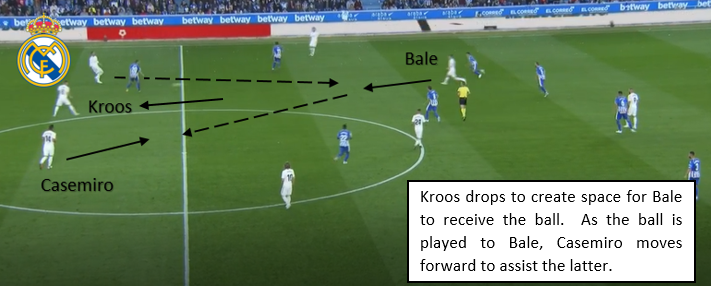
Typical passes in midfield are of a high tempo and switches in play occur regularly. Defending against such a style is very tiring both physically and mentally. To be able to maintain playing at a high tempo, the midfielders are required to scan the pitch hundreds of times during a match. They must remain alert and focused so to be able to receive and play the ball quickly. They require the endurance to perform this with precision throughout the match. In such a playing style the stress imposed on the mental aspect is extremely high. We cannot afford to have players that switch off or to just switch on only when they receive the ball at their feet.
When one of the central defenders moves forward with the ball, the closest midfielder – usually the defensive midfielder – moves back to cover him. By doing so, he is offering the defender who moved forward with the ball both support and security behind him. It is common to see this manoeuvre in Spain, especially with the national team and top clubs.
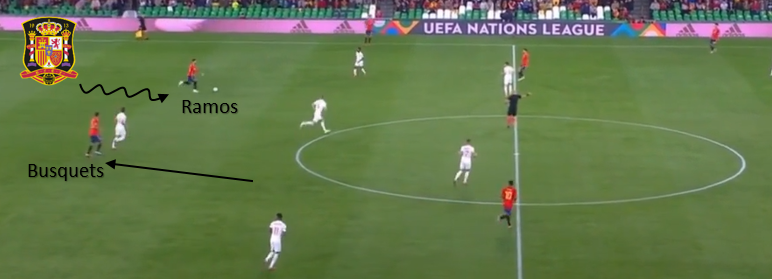
The full backs
Although they are called full backs, in Spain both with the national team and top clubs these players play more as wing backs. They participate in the build-up of an attack and we usually have both full backs playing high up the pitch giving the team width. During the first phase of the build-up the full backs remain close to the central defenders providing support to build-up from the flanks if the opponent is compact centrally.
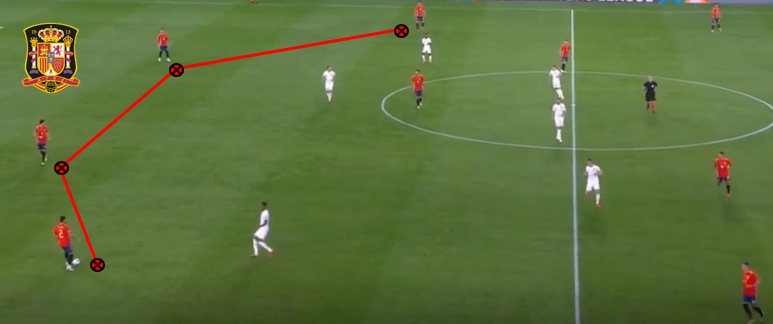
Providing width and be ready to receive the ball from a switch in play is a typical aspect in the game of Spanish fullbacks. When the ball moves at the feet of one of the central defenders from the opposite flank, the full back moves close to the back line but still wide to receive unopposed. From there a new attack can be constructed.
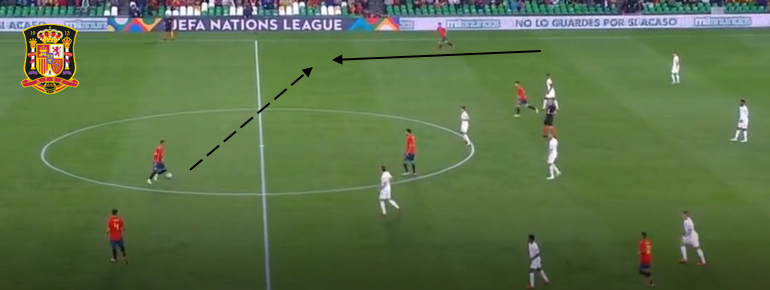
Full backs are continuously searching to verticalize play. It is typical of them to perform various passes and off-the-ball runs. They are constantly involved in the build-up to provide wide options in cases where penetration from the middle is difficult and risky to achieve. In the next diagram, F.C. Barcelona’s right full back Sergi Roberto passes to Suárez on the right flank and initiates a forward run. This run could either provide Sergi Roberto with the opportunity to receive behind the defenders, or to open up space for the closest midfielder to receive the ball from Suárez.
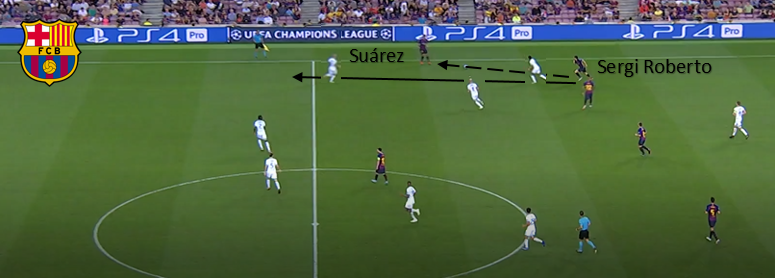
When playing with a formation with three forwards close to each other in a 1-4-3-3 system of play, space opens up for the full backs to attack down the flank. This also occurs in other systems such as the 1-4-2-3-1 when the lateral midfielders are asked to overload the inside channels. Long diagonal passes aimed at switching the point of attack could then successfully be played after the full back advances into high zones of the field unopposed.
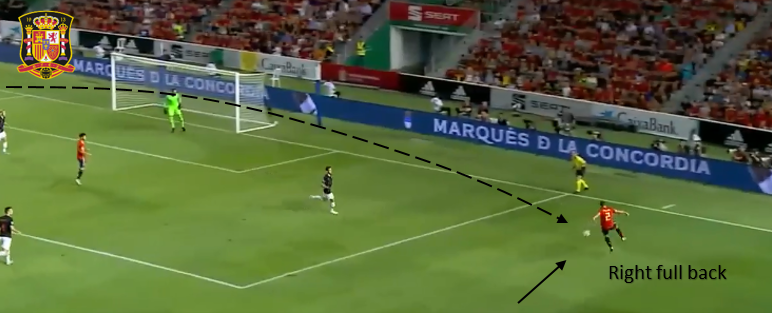
This is a very effective way of getting around the defence. It is also very dangerous for the defenders as they have to shift rapidly and re-adjust themselves to defend the attack coming from a new angle. When the full back roams forward, a central midfielder, the one with the most defensive characteristics remains close to the central defenders. However, this typically only occurs if the opponents leave two forwards close to the half way line.
In La Liga full backs excel in 1v1 offensive duels. This creates numerical superiority down the flank near the ball zone with the lateral midfielder or forward combining with the full back against the opposition’s full back. The team will also have qualitative superiority in the attacking phase as the level of the 1v1 of both offensive players is high. Attacking runs might also take place by having the full backs cutting inside in a central position. Sometimes they even become like centre forwards. In this case a high level of communication between the full back and lateral midfielder is required.
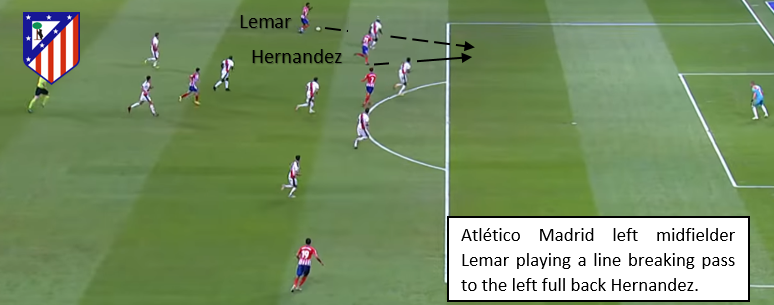
The wide midfielders or outside forwards
The difference between the outside midfielders and the outside forwards is that the latter are positioned higher up the pitch and closer to the striker. During an attack and when the ball is located either in the middle or attacking thirds they move inside to overload the inside. This creates space on the flanks as the opposition’s full backs are attracted to their runs. Our full backs will move forward to exploit this space. Having the full backs wide and the outside forwards or wide midfielders in the middle creates more options to play the ball around and into the penalty area.
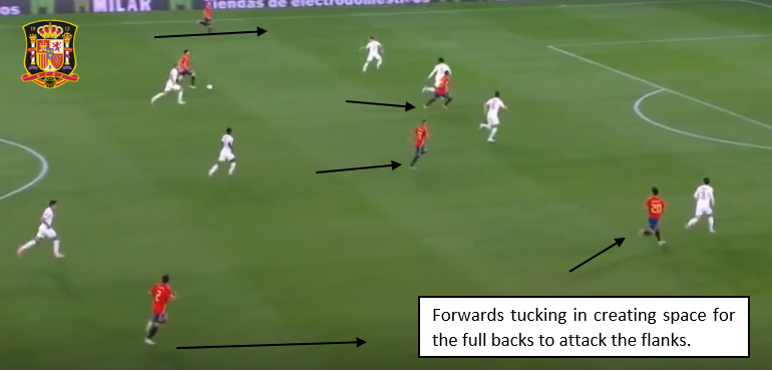
Lateral midfielders or inside forwards require that they work very close with full backs. This way they overload the flanks, create more options (crosses, cuts towards the inside, passes towards the inside, penetrating passes behind the full back, etc.), and also look to pull the opposing full backs out of good covering positions.
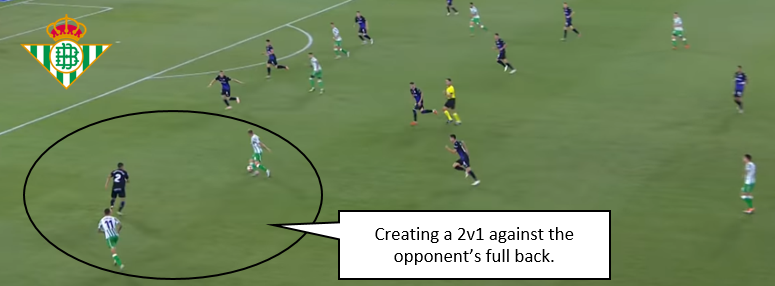
Teams like F.C. Barcelona and Real Madrid C.F. always leave their full backs high and wide. It is typical of their outside forwards to move towards into the half spaces and then explode towards the inside, thus attracting their markers with them and freeing the flank they want the ball to be played into. The player on the ball in the midfield third of the pitch then has the required space to play the ball in behind the opposition’s defence and into the space in front of the full back.
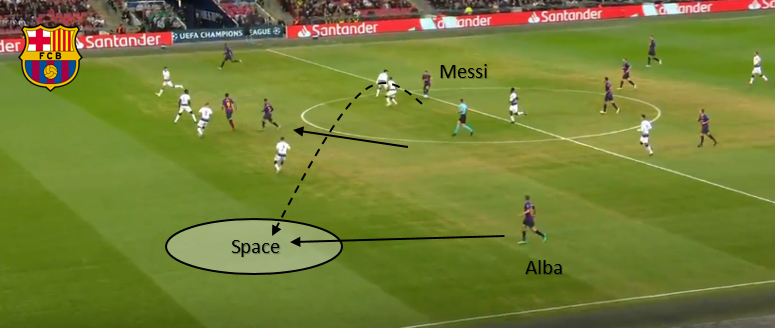
With teams who play with three strikers and attacking full backs, when the ball is at the full back’s feet high up the pitch, the lateral attacker drops diagonally behind and towards the inside. This movement creates space for the full back to take his opposite number in a 1v1 duel, while at the same time diverting the other defenders’ focus on him. As a result, the attackers gain that crucial seconds to get into ideal positions to receive the ball, play quick passes to open up the defence and finish the action with a shot on goal.
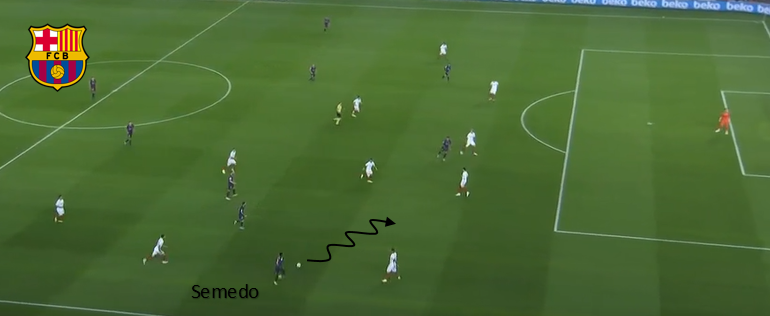
The forward line
Top Spanish teams look for forwards that are highly skilled and who can read the game well. The traditional target player to whom long balls are played and who can hold the ball to midfielders joining the attack does not exist. Forwards in Spain work very well collectively, creating space for either themselves or for their teammates. The level of tactical communication between them and the rest of the team, especially the midfielders, is very high.
Forwards in Spain look to exploit the spaces between the defence and midfield lines very well. They very often drop into this gap to pull central defenders out of ideal covering positions or to at least divert the defenders’ attention onto them for a few seconds which may be critical for a goal to be scored. As soon as the striker drops into this space, another forward or a midfielder who moves into a higher position, tries to cut inside from the defenders’ blind spot while the player on the ball delivers the ball onto the danger zone.
Every team approaches the game in a different way. What is common in Spain is the way teams circulate the ball at high speeds, and the off-the-ball movements they perform to create the much needed space to penetrate. Attackers work very close with midfielders in the sense that they frequently rotate positions with the aim of unbalancing the opponent’s defensive structure.
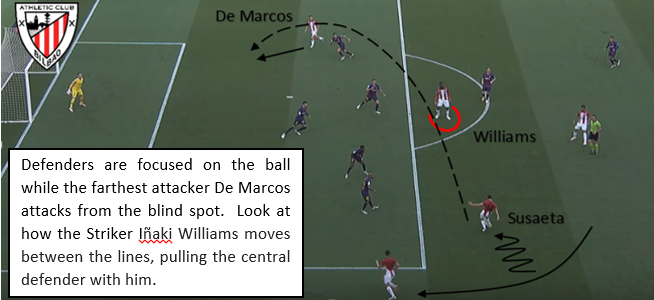
Teams that play with two strikers such as Atlético De Madrid, have them positioned diagonally to each other. One of the strikers drops between the defence and midfield lines while the other gets high to commit the defenders to track him. This creates space between the lines which can be exploited by quick off-the-ball movement and circulation of the ball. In the below diagram look at how Griezmann gets behind the defender to receive a line-breaking pass in space.
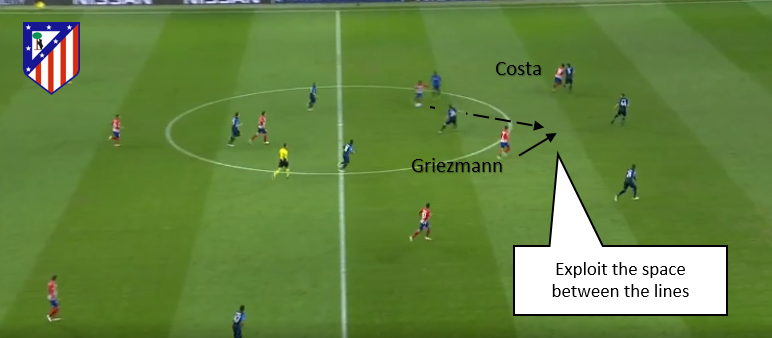
Diego Costa and Antoine Griezmann provide a superb example of how two strikers who communicate well with each other can through well-timed off the ball movements and perfect rhythm can penetrate the best organised defences.
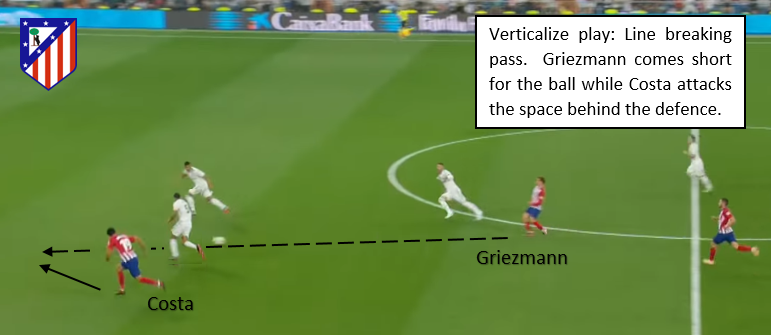
Exploiting the space between the opposition’s defence and midfield lines is one of the outcomes required in order to create a goal-scoring chance. The forwards aim to explode this space by receiving the ball and be able to turn and face the defenders. In the below image on the far side of the ball two 1v1 situations (encircled) have been created. Being in the space before the ball is passed enables the forward to receive the ball already facing the opponent’s goal. It is even harder for the defending team to win the ball, if the forwards excel in 1v1 attacking as is the case with F.C. Barcelona.
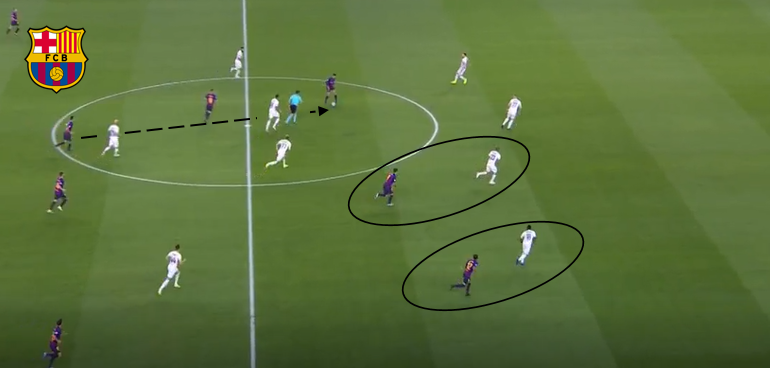
Teams whose style is to dominate play tend to push their forwards high in search of verticality. By having strikers pushing high, space for the ball to be played through could be created. Players bearing a high level of game intelligence and skill level could exploit such an opportunity with well-aimed and well-timed through passes.
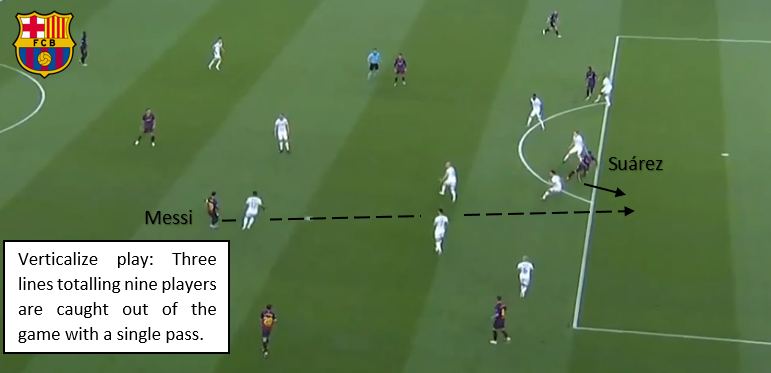
When playing with a front three, some teams such as F.C. Barcelona opt to play the three forwards at a close proximity with each other. This gets the opposition’s back four compact thus leaving space on the flanks for the full backs to advance. The setup of the front three also allows for 1v1 situations to take place.
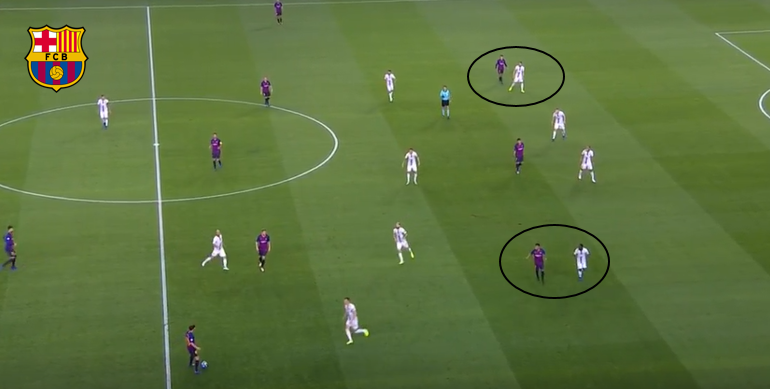
For an effective attack to be carried out, mobility of players in order to create the necessary space to play forward is imperative. The forwards must non-verbally communicate with each other and with players from the other lines close to them in order to create the necessary space to verticalize play. Forwards typically come short to make themselves available to receive the ball. This provides the attacking team with two alternatives. One is to play a direct pass into the feet of the forward, while the other is to play into the path of a midfielder or full back (as is the case in the below diagram) who pushes forward in attack.
